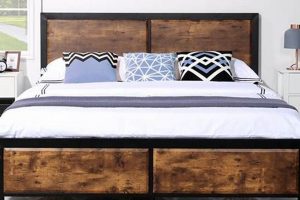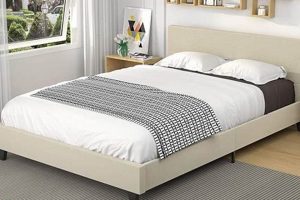This type of furniture combines a bed frame, typically constructed from timber, with a foldable mattress designed for dual functionality. The frame provides support and structure, while the mattress offers a sleeping or seating surface. An example would be a living room piece that easily converts from a sofa to a sleeping area for guests.
The appeal of this furniture lies in its space-saving capabilities and versatility. It serves as a practical solution for smaller living spaces, providing both seating and sleeping accommodations. Historically, this design has evolved from simple Japanese sleeping mats into a modern, multi-functional piece that blends comfort with aesthetic appeal, offering an affordable and adaptable furnishing option.
The following sections will delve into various aspects of this furniture, including frame construction materials, mattress types, size considerations, style variations, and practical tips for selection and maintenance.
Selection and Maintenance Guidelines
The following guidelines aim to provide objective advice for choosing and maintaining this furniture, ensuring long-term satisfaction and optimal utility.
Tip 1: Frame Material Assessment: Prioritize hardwoods like oak or maple for superior durability and resistance to wear. Softer woods, while more affordable, may exhibit diminished structural integrity over time. For example, a frame constructed from solid oak is better suited for frequent use than one made from pine.
Tip 2: Mattress Density Evaluation: Consider the foam density of the mattress. Higher density foams offer greater support and resilience, particularly for sleeping. Inspect the mattress core for consistent fill and avoid mattresses with noticeable indentations or uneven surfaces.
Tip 3: Mechanism Inspection: Evaluate the folding mechanism for smooth and reliable operation. A well-engineered mechanism should operate quietly and securely lock into both seating and sleeping positions. Test the mechanism several times before purchase to ensure proper functionality.
Tip 4: Size and Space Considerations: Accurately measure the intended space before selecting a model. Account for the unit’s dimensions in both seating and sleeping configurations to ensure it fits comfortably within the designated area. Consider models with a smaller footprint for limited spaces.
Tip 5: Style Compatibility: Choose a design that complements existing dcor. The frame’s finish and fabric of the mattress should harmonize with the overall aesthetic of the room. Neutral colors and classic designs offer greater versatility.
Tip 6: Regular Maintenance: Implement a routine cleaning schedule. Vacuum the mattress regularly to remove dust and debris. Promptly address spills to prevent stains and odors. Consider using a mattress protector to prolong its lifespan.
Tip 7: Hardware Inspection: Periodically inspect all screws, bolts, and hinges. Tighten any loose hardware to maintain structural stability and prevent premature wear. Lubricate moving parts as needed to ensure smooth operation of the folding mechanism.
Adhering to these guidelines facilitates informed decision-making and responsible maintenance, leading to optimized performance and extended lifespan of the furniture.
The subsequent sections will explore potential issues and troubleshooting techniques related to this type of furniture.
1. Frame Wood Durability
The longevity and structural integrity of a timber frame are directly correlated to the overall performance and lifespan of the associated foldable bed and mattress. The selection of appropriate lumber is paramount in ensuring that the furniture withstands repeated use and weight distribution.
- Wood Species Selection
Hardwood species, such as oak, maple, and birch, exhibit superior strength and resistance to deformation compared to softwood species like pine or fir. Selecting a hardwood frame contributes to increased stability and reduced likelihood of structural failure under stress. An example is using oak for its proven load-bearing capacity, minimizing the risk of frame cracking or warping under regular use.
- Wood Treatment and Finishing
Proper treatment and finishing of the wooden frame enhance its resistance to environmental factors such as moisture and temperature fluctuations. Sealants and varnishes protect the timber from water damage, preventing rot and decay, which can compromise structural integrity over time. A quality finish also guards against insect infestation, further prolonging the life of the frame.
- Joint Construction and Reinforcement
The method of joining wood components significantly influences the overall strength of the frame. Mortise-and-tenon, dovetail, or dowel joints, when properly executed, create robust connections that withstand considerable stress. Reinforcements, such as metal brackets or corner braces, provide additional support at critical stress points, enhancing structural stability.
- Load-Bearing Capacity
The type of wood selected must have the ability to bear weight load. Higher density wood should be applied. The weight capacity of the frame is determined by the selected wood species. The lumber grade and dimension must meet the stress and strain calculation needed to support the mattress and user without structural damage.
In summation, the durability of the supporting structure is a critical determinant of the overall lifespan and functionality of this furniture. Investing in a high-quality frame constructed from durable materials and employing robust construction techniques ensures lasting performance and user satisfaction. Neglecting these aspects can lead to premature failure and necessitate costly repairs or replacements. The selection of durable timber frames, therefore, represents a significant investment in the long-term utility and value of such furniture.
2. Mattress Core Composition
The mattress core composition directly influences the comfort, support, and durability of the mattress, which in turn affects the overall usability and longevity of a complete foldable bed set. The core material dictates how well the mattress conforms to the body, distributes weight, and resists compression over time. Inadequate core material selection can lead to discomfort, poor sleep quality, and premature sagging, ultimately diminishing the value of the entire furniture piece. For instance, a low-density foam core may offer initial softness but quickly degrade under regular use, providing insufficient support and necessitating frequent replacement. A high-density latex or innerspring core, while potentially more expensive upfront, offers superior support, resilience, and lifespan, enhancing the overall quality and value of the combined unit.
The specific design of the bed frame also interacts with the mattress core. A frame with widely spaced slats may allow a softer mattress core to sag excessively, negating the intended support. Conversely, a frame with closely spaced slats or a solid platform can provide additional support, allowing for the use of a wider range of mattress core materials. For example, a cotton or fiber core, which may lack inherent support, can be effectively used in combination with a solid platform frame to provide a firm and stable sleeping surface. The selection of the mattress core must therefore be carefully considered in relation to the supporting structure’s design to ensure optimal performance and longevity.
In conclusion, the mattress core composition is a critical component that significantly impacts the user experience and the lifespan of a bed-and-mattress combination. Careful consideration of core materials, density, and support characteristics, in conjunction with the frame design, is essential for maximizing comfort, durability, and overall value. The selection process should prioritize materials and construction methods that align with the intended use and desired level of support, thereby ensuring that the complete furniture set provides long-lasting comfort and satisfaction.
3. Folding Mechanism Reliability
The reliability of the folding mechanism is paramount to the overall functionality and longevity of any bed-and-mattress setup. The mechanism’s ability to repeatedly and consistently transition between seating and sleeping configurations directly impacts the user experience and the furniture’s practical value.
- Component Durability and Material Selection
The materials used in the mechanism’s construction, such as steel, hinges, and connecting hardware, must be robust and resistant to wear and tear. High-quality steel alloys with appropriate surface treatments are essential for preventing corrosion and ensuring smooth operation over time. For example, a mechanism using hardened steel hinges with a powder-coated finish will exhibit greater resistance to rust and bending compared to one constructed from lower-grade materials.
- Design Simplicity and Mechanical Advantage
A simpler, more mechanically efficient design minimizes stress on individual components, thereby reducing the likelihood of failure. Mechanisms that employ levers and linkages to reduce the force required for folding and unfolding contribute to increased reliability and ease of use. A design that reduces the number of moving parts and stress points will typically exhibit greater durability.
- Locking Mechanism Security
A secure and reliable locking mechanism is crucial for ensuring the safety and stability of the furniture in both seating and sleeping configurations. The locking mechanism must prevent unintended folding or unfolding, which could result in injury or damage. Examples of reliable locking mechanisms include spring-loaded latches, cam locks, and friction-based locking systems. The locking mechanism should be easy to engage and disengage while providing a positive and secure hold.
- Maintenance and Serviceability
A well-designed folding mechanism should be easily accessible for maintenance and lubrication. Periodic lubrication of moving parts is essential for maintaining smooth operation and preventing premature wear. Mechanisms that are difficult to access for maintenance or that require specialized tools for repair are less likely to be properly maintained, leading to reduced reliability over time. The availability of replacement parts and service manuals also contributes to the long-term serviceability and reliability of the folding mechanism.
The long-term utility is intrinsically linked to the robustness of its folding mechanism. Investing in furniture with a well-engineered and durable mechanism ensures ease of use, safety, and extended lifespan, ultimately enhancing the value and practicality of the convertible furniture piece.
4. Size Accommodation
The relationship between size accommodation and bed-and-foldable-mattress units is a critical determinant of its functionality and suitability for a given space. Size, in this context, refers not only to the overall dimensions of the furniture in both its seating and sleeping configurations but also to its ability to integrate effectively within the physical constraints of a room. Inadequate size accommodation can lead to practical issues, such as obstruction of walkways, limited space for other furnishings, and difficulty in transitioning between modes. Conversely, thoughtful consideration of size ensures optimal utilization of available space and enhanced user experience. For example, a compact-sized unit may be ideal for small apartments or guest rooms where space is at a premium, whereas larger models are more appropriate for spacious living areas where a more substantial seating or sleeping surface is desired.
The selection of an appropriate size is also influenced by the intended use of the furniture. If primarily intended for occasional use as a guest bed, a smaller-sized model may suffice. However, if it will serve as a primary sleeping surface, a larger size that provides ample room for comfortable rest is essential. Additionally, consideration must be given to the height of the frame and the thickness of the mattress, as these factors impact the overall comfort and accessibility of the seating and sleeping surfaces. For instance, a frame that is too low may make it difficult for elderly individuals to get in and out of bed, while a mattress that is too thick may render the seating position uncomfortable.
In summary, size accommodation is a fundamental consideration in the selection of convertible furniture. Careful evaluation of available space, intended use, and user preferences is essential for ensuring that the chosen size is appropriate and that the furniture effectively fulfills its intended function. Neglecting size accommodation can lead to practical difficulties and compromised user satisfaction, whereas thoughtful attention to size optimization contributes to a more comfortable, functional, and aesthetically pleasing living environment. Size consideration must also consider storage and easy mobility, which are also important factors of concern.
5. Style Integration
The aesthetic harmony of a foldable bed and mattress unit with its surrounding environment, termed “style integration,” significantly impacts its perceived value and user satisfaction. The timber frame, acting as a visual anchor, sets the tone for this integration. A mismatch between the furniture’s design and the room’s existing aesthetic disrupts visual coherence, potentially diminishing the overall appeal of the space. Conversely, thoughtful selection of frame finishes, mattress fabrics, and overall design elements enhances the room’s aesthetic, creating a cohesive and inviting atmosphere. For instance, a rustic-style frame constructed from reclaimed timber complements a farmhouse-themed interior, while a sleek, minimalist frame with clean lines aligns well with a modern, contemporary setting. The fabric choice for the mattress also plays a crucial role, with neutral tones and subtle patterns offering greater versatility across diverse design schemes, and bold colors or intricate patterns serving as focal points within more eclectic spaces.
Practical application of style integration involves considering several factors. The existing color palette of the room, the texture of other furnishings, and the overall architectural style should inform the selection process. Wood finishes should either complement or deliberately contrast with existing timber elements, such as flooring or trim. Mattress fabrics should be chosen to either blend seamlessly with the surrounding decor or to provide a pop of color or visual interest. Furthermore, the style of the furniture should align with the functional requirements of the space. A more formal living room might benefit from a sophisticated, tailored design, while a casual family room might be better suited to a more relaxed and comfortable aesthetic. For example, selecting a dark mahogany frame with a damask mattress cover for a formal study adds an element of refinement. In contrast, a lighter pine frame with a durable denim cover would be better suited for a casual family room.
In summary, style integration is an essential consideration in the selection and placement of foldable bed and mattress units. By carefully aligning the furniture’s design with the existing aesthetic of the room, homeowners can create a cohesive and visually appealing space that enhances both functionality and comfort. Challenges to achieving seamless style integration include limited product availability in certain design styles and the potential for subjective preferences to conflict with objective design principles. However, by prioritizing thoughtful planning and a keen understanding of design principles, effective style integration can be achieved, transforming this practical piece of furniture into a stylish and integral component of the home’s interior.
Frequently Asked Questions
The following provides clarification on common inquiries regarding these furniture systems, addressing concerns related to construction, functionality, and maintenance.
Question 1: What is the expected lifespan of a frame constructed from solid wood?
The lifespan of a timber frame is contingent upon wood species, construction quality, and usage frequency. Hardwood frames, such as oak or maple, subjected to moderate use, can endure for several decades. Conversely, softwood frames, such as pine, exposed to heavy use, may exhibit signs of wear and structural compromise within a shorter timeframe.
Question 2: How does mattress density impact sleeping comfort?
Mattress density directly affects support and pressure distribution. Higher-density mattresses provide enhanced support and conform more effectively to body contours, mitigating pressure points and promoting spinal alignment. Lower-density mattresses offer less support and are more susceptible to compression, potentially leading to discomfort and compromised sleep quality.
Question 3: What maintenance procedures are recommended for the folding mechanism?
Routine maintenance of the folding mechanism is crucial for ensuring smooth operation and preventing premature wear. Periodic lubrication of moving parts with appropriate lubricants, as specified by the manufacturer, is recommended. Additionally, regular inspection of hardware, such as screws and bolts, and tightening of any loose components are essential.
Question 4: Can the mattress be replaced independently of the frame?
In most instances, the mattress can be replaced independently of the frame. However, compatibility between the mattress dimensions and frame specifications must be ensured. Selecting a replacement mattress that adheres to the original dimensions and weight limits of the frame is essential for maintaining stability and preventing damage.
Question 5: What factors should be considered when selecting a frame for limited spaces?
When selecting a frame for constrained environments, emphasis should be placed on compact dimensions and space-saving designs. Models with a streamlined profile and minimal footprint are preferable. Additionally, the ease of transitioning between seating and sleeping configurations should be considered to maximize functionality within limited areas.
Question 6: How does fabric selection impact the overall durability?
Fabric selection significantly affects the overall durability and resistance to wear. Durable fabrics, such as tightly woven cotton or synthetic blends, are more resistant to abrasion, stains, and fading. Selecting fabrics with a higher thread count and inherent stain-resistant properties contributes to extended lifespan and easier maintenance.
The above questions and answers summarize common inquiries concerning selection, usage, and maintenance. Careful consideration of these elements contributes to informed purchasing decisions and responsible furniture management.
The subsequent section will examine potential issues and solutions encountered using this particular type of furniture.
Conclusion
This exploration has detailed the critical factors governing the selection, utilization, and maintenance of wood frame futon mattress combinations. Emphasis has been placed on the interplay between frame durability, mattress core composition, folding mechanism reliability, size accommodation, and stylistic integration. Understanding these elements facilitates informed decision-making, contributing to enhanced user satisfaction and optimized furniture longevity.
The information presented underscores the importance of considering both functional requirements and aesthetic preferences when integrating a wood frame futon mattress into a living space. Careful evaluation of these aspects ensures a lasting, practical, and visually pleasing addition to the home. Neglecting these considerations may lead to compromised functionality and premature deterioration. Therefore, prospective buyers are encouraged to prioritize quality materials, robust construction, and diligent maintenance practices to maximize the value and lifespan of their investment.



![Best Queen Futon Mattress & Frame [Deals + Guide] Organic & Natural Mattress Buyer’s Guide: Non-Toxic Sleep Solutions Best Queen Futon Mattress & Frame [Deals + Guide] | Organic & Natural Mattress Buyer’s Guide: Non-Toxic Sleep Solutions](https://mattressworldpa.com/wp-content/uploads/2025/07/th-3077-300x200.jpg)

![Best California King Mattress & Frame [Guide] Organic & Natural Mattress Buyer’s Guide: Non-Toxic Sleep Solutions Best California King Mattress & Frame [Guide] | Organic & Natural Mattress Buyer’s Guide: Non-Toxic Sleep Solutions](https://mattressworldpa.com/wp-content/uploads/2025/07/th-3075-300x200.jpg)
![Best Full Size Mattress Metal Frame [Guide & Tips] Organic & Natural Mattress Buyer’s Guide: Non-Toxic Sleep Solutions Best Full Size Mattress Metal Frame [Guide & Tips] | Organic & Natural Mattress Buyer’s Guide: Non-Toxic Sleep Solutions](https://mattressworldpa.com/wp-content/uploads/2025/07/th-3074-300x200.jpg)
